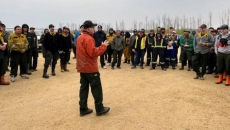A wildfire that has forced thousands out of their homes in the Alberta oilsands hub city of Fort McMurray was held in place Thursday as rain and cooler temperatures swept the area.
Alberta Wildfire information officer Christie Tucker said the blaze remained out of control – the only such designated fire in the province – but it did not grow overnight and remained at 200 square kilometres in size.
“We’re seeing rain and cooler temperatures in much of the province this week, but unfortunately the northern part of the province is expected to stay drier and warmer,” Tucker told a news conference in Edmonton.
Wildfire MWF024 is now classified as being held. Wildfire MWF017 remains out of control at 19,820 hectares. A more accurate scan of the wildfire perimeter has resulted in a reduced area affected by wildfire. For more information: https://t.co/ANhyIyWgtt pic.twitter.com/Xvme1vTTZG
— Alberta Wildfire (@AlbertaWildfire) May 16, 2024
The blaze remained just under six kilometres from the southwest outskirts of the community and less than five kilometres from the main highway south.
In Fort McMurray, crews woke up to light rain, overcast skies and cooler temperatures.
Water from above was augmented with help on the ground.
Thick red hoses mounted to water cannons blasted enough water into dry ditches to fill an Olympic-sized swimming pool every 90 minutes.
The hoses, six kilometres of them, are powered by batteries of 600-horsepower pumps.
The soakers help protect buildings, homes and vital routes in and out of the city against flames that forced the evacuation of about 6,600 residents out of four neighbourhoods on Tuesday.
The equipment represents one of the lessons learned after the catastrophic wildfire that scorched the community in 2016, forcing 80,000 residents out of the city and surrounding area and destroying more than 2,000 homes.
"The system was designed after 2016," said Derek Sommerville, a wildfire specialist with Fire and Flood Emergency Services in Alberta.
"We can cover large distances. That frees up traditional mobile resources like fire trucks and helicopters to deal with higher priority areas."
Evacuated residents have been told they may be able to return as early as Tuesday. The rest of the city and other surrounding subdivisions remain under evacuation alert.
Other fires across Western Canada have forced residents out of their homes.
In northern British Columbia, the wildfire service said the blaze threatening Fort Nelson spans almost 130 square kilometres, but it was spreading away from the town along its southern flank.
Fort Nelson, a town of 4,700, remained under evacuation order.
The agency said cooler temperatures and higher humidity were expected to help the firefighting effort over the next couple of days.
Rob Fraser, the mayor of the Northern Rockies Regional Municipality, said he's confident there will soon be word that the fire is no longer threatening the town.
In Manitoba, about 500 people remained out of the remote northwestern community of Cranberry Portage.
Officials said the fire there was about 80 per cent contained and residents might be able to return this weekend.
The Manitoba and federal governments announced Thursday a deal to spend a combined $38.4 million over four years to boost firefighting and prevention.
The money, to be split evenly, is aimed at buying more firefighting, boosting training, and increasing the number of skilled wildland firefighters and other staff.






